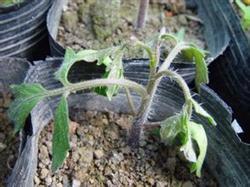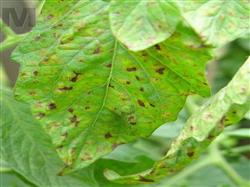How to control tomato sesame spot disease with chemicals

★ symptoms: tomato sesame spot, also known as brown spot. It mainly infects leaves, petioles, pedicels and fruits. The primary diameter of the leaf is 1mm round or nearly round with obvious grayish-brown spots, the disease part becomes thin and sunken, with light, especially on the back of the leaf, which is different from other leaf spot diseases. Large spots sometimes appear wheel lines, when the humidity is high, there are dark brown mildew; petioles and fruit stalks are infected, the disease spots are gray-brown sunken, and black mildew grows when the humidity is high; the disease spots vary in size, sometimes in strips. The pathogen of ★: Helminthosporium carposaprum Pollack called tomato helminthosporium, which belongs to the subphylum of semiknowns. The hyphae are colorless, or yellowish brown to brown. The conidiophores are clustered and slender, and the basal segments of the peduncles are slightly inflated. The conidia are oblong or clavate, yellowish brown, string-shaped at the top of the sporophore, with 20 septum, 56.9 Mel 134.9 × 4.6 Mel 11.4 microns in size, and the germ tube protrudes from both ends of the spore during germination. The transmission route and disease condition of ★: the mycelium overwintered mainly with the disease residue in the field. The conidia were produced when the conditions were suitable, and the conidia were splashed on the host plant by airflow and Rain Water, invaded from the stomata, and the incubation period was 2Mel for 3 days. The suitable temperature for the development of the pathogen was 25 ℃ and 28 ℃, and it was suitable for PH6.5-7.5. It is easy to be popular in high temperature and humidity, especially in rainy and hot season. In addition, the disease was serious due to wet vegetable land, weak tomato growth, over-dense planting, poor ventilation and light transmission or lack of fertilizer. ★ control methods: (1) selection of disease-resistant varieties. Such as Yuenong 2, early sparrow drill and hybrid generation 1. (2) to strengthen field management, high border and deep furrow planting should be adopted in low-lying or water-prone areas; it should not be too dense to improve field permeability; formula fertilization technology should be adopted to spray 4000 times of multi-effect liquid, or 1.4% compound sodium nitrate solution of 7000 times to improve plant disease resistance; remove the disease residue after harvest and turn it deeply in time. (3) at the initial stage of the disease, 25% ammonia copper solution was sprayed 500 times, or 77% can kill wettable powder 400-500 times solution, 1 200 Bordeaux solution, 50% mixed sulfur suspension 500 times solution, 50% polysulfide suspension or methyl thiophanate wettable powder 600 times solution, once every 10 days, continuous prevention and treatment for 3 times.
- Prev

Methods to prevent Tomato stunting Disease
Tomato quenching disease mostly occurs in the seedling stage, seeds are vulnerable before unearthed, often appear rotten seeds, dead seedlings, quenching and other symptoms. The prevention and control methods are as follows: 1. Sterilize the seedling bed and choose a place with slightly higher terrain to facilitate drainage. 2, carry on the management to the seedling stage, sow seed.
- Next

Tomato pruning is skillful.
Symptoms: tomato bacterial spot disease, also known as bacterial microspot disease. It mainly harms leaves, stems, flowers, petioles and fruits, especially the leaf margin and immature fruits. Leaves are infected with dark brown to black spots, often surrounded by yellow halos; petioles and stems are infected with black spots; young green fruits are infected with disease.
Related
- Where is it suitable to grow horseradish in China? it is expected to see the middle altitude horseradish in Alishan.
- How to prevent tomato virus disease reasonably? (Control methods included)
- Many people like to plant towel gourd on the balcony. What are the main points of this method and management?
- What crops can chili peppers be mixed with?
- Fertilization techniques and matters needing attention in Tomato
- What are the grafting techniques for peach seedlings in spring?
- Harm and control methods of root swelling disease of Chinese cabbage
- What are the pests of sweet potatoes? How to prevent and cure it?
- Symptoms, causes and Control methods of navel Rot in Tomato
- The cause of "Cucumber rotten bibcock" in Farmers' planting Cucumber and its Control Plan

